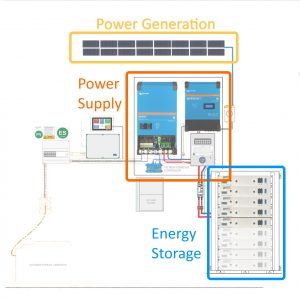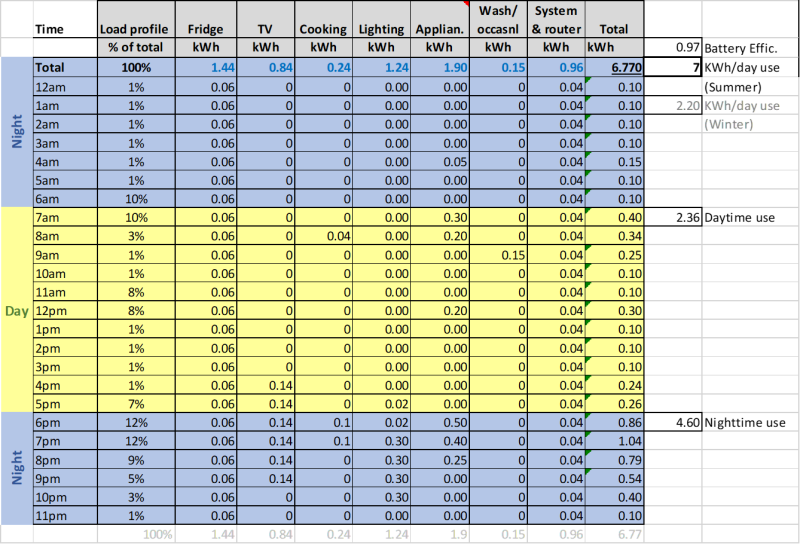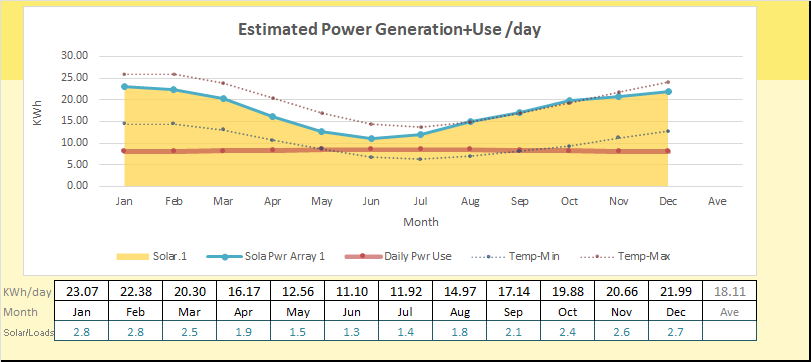Off-grid Body-of-Knowledge
This is a very short summary of how we specify off-grid systems for our customers:
- Basics of Power & Electricity
- Power generation (e.g. Solar Panels)
- Storage – Batteries
- Power supply: Inverters & Electrical
- System Control, Generators & Using systems over time
The Basics of Power & Electricity
First, if you need to, run through some energy and electrical terms like KW, KWh and KVA at your leisure at the FAQ page. Then you can understand a whole Off-grid system which is sized in those units.
Now for a basic overview, any off-grid system has:
- Electrical Power generation, (e.g. Solar panels with KW rating)
- Energy Storage (e.g. Batteries with KWh rating)
- Power Supply Capability (i.e. Inverters with KVA or KW rating)
Almost all off-grid, or ‘standalone power’ systems will have a mixture of these elements. Most will also have backup generation, such as a petrol generator.

Power generation (e.g. Solar Panels)
The principle of a system, is that whatever energy you use in appliances for living, has to be generated, so that generation must be at least equal to the planned power use. An average household will use about 20-25KWh per day of power, which reduces to 12-22KWh per day off-grid with energy efficiency. You may use less or more than that amount, you should have a fairly good idea before you start, what that KWh load will be. It’s also helpful to know what the day/night breakdown of your loads is. To get to that, ecoCool creates a granular review of each appliance you have, when you use it, and for how long, in a 24hr Load Analysis:

Once we establish your daily loads, we work on 2 assumptions: you will need at least 20-30% more than that KWh amount, let’s say its 17KWh/day. And in Australia, when generating power from solar panels, your worst generation months will be winter: June/July.
We calculate your daily energy generation using your location, the orientation of your solar array, and the size of the solar array. All of those factors, including things like shading and dust fouling, affect the normal solar harvested, so they are factored in. That means:
- We need to know where in Australia you live, further south reduces winter solar power and further north you will have a more even seasonal solar generation;
- We select a solar PV array (eg 15 x 400W solar panels to make a 6000W (6KW) array) to give you at least 1.25 times your daily KWh load needs; and
- We ensure that heat, dust and electrical inefficiencies are accounted for, so you actually make 1.25 times (at least in Winter) more energy than you need, daily.
And that should look like this, if we graph over the year how much solar you make daily:

To be clear, this graph shows you the daily average solar harvested, by month. And it also shows your electrical loads, and the local temperatures. You can see that the loads, the RED line is always below the solar generated daily, the blue line. And that in the worst month for solar, June, there is 1.3 x the solar generated daily, compared to the power used, meaning this system makes more energy than it uses. Designers like to see at least 1.25 times more energy generated, than used, (the bottom line) so you will always have more than needed.
You can use a fuel generator to ‘top up’ your solar generation, for example if you budget does not extend to a larger system. Then the red line of how much power used, might exceed, or be above the blue line of solar generation for a period during winter, called a hybrid system.
Next is how we choose, and size battery storage for off-grid systems.
Storage – Batteries
More coming soon…
IMAGE…
Backup power from Generators
You can see that in Winter your actual power use might dip below the solar power generated, so you might add extra power on some days with a backup petrol or diesel generator. Or you might have another way of making power such as a wind turbine, micro-hydro, a hydrogen fuel cell, or biogas which supplements power, or may supply all of it.
